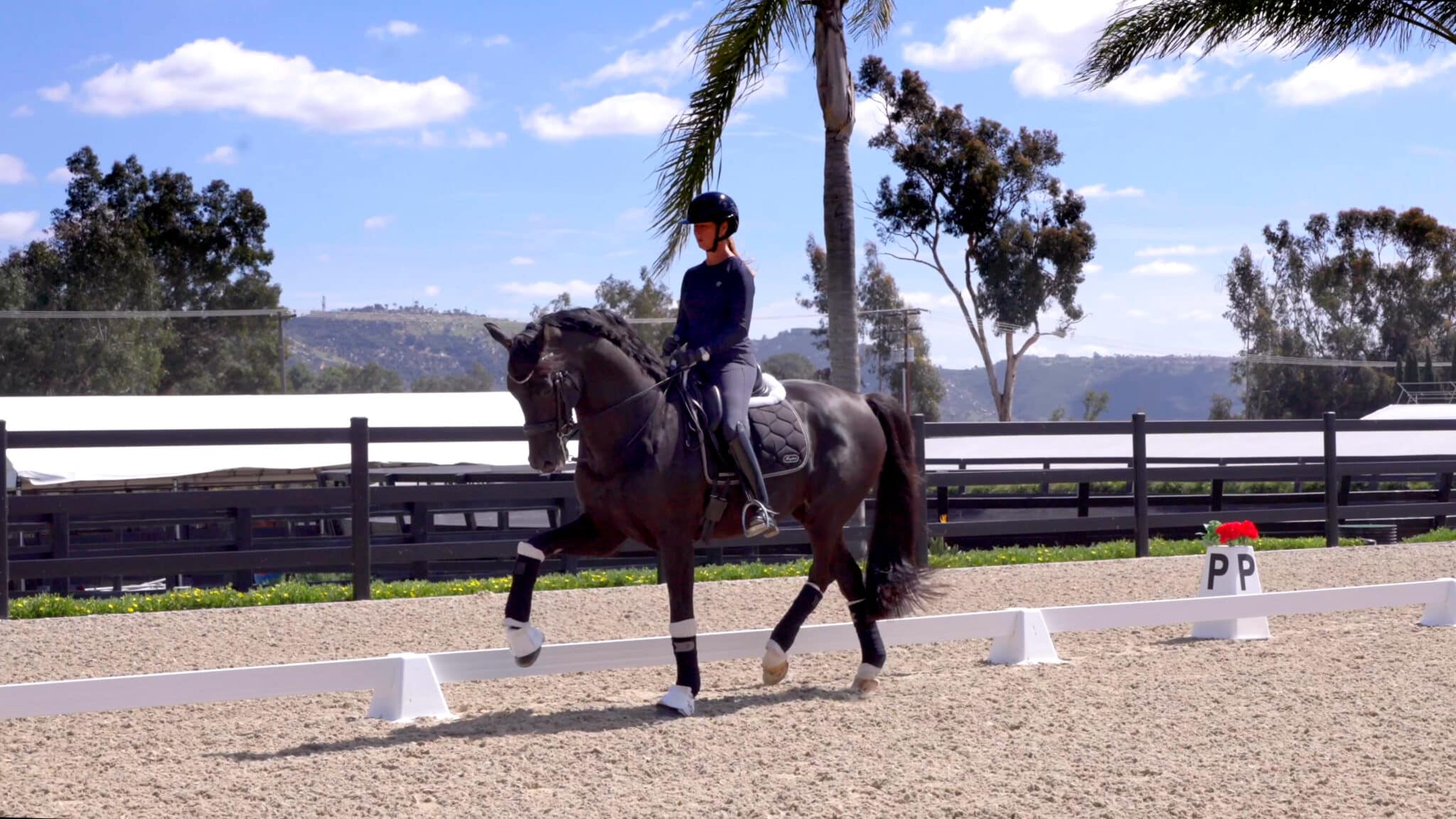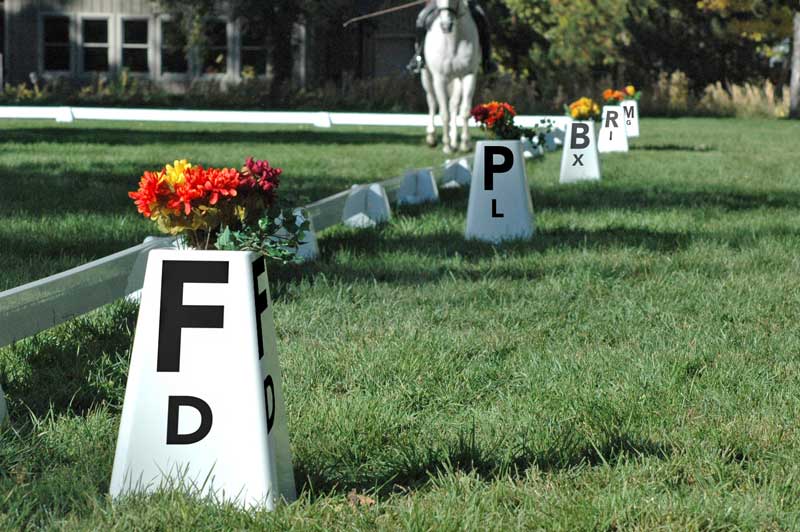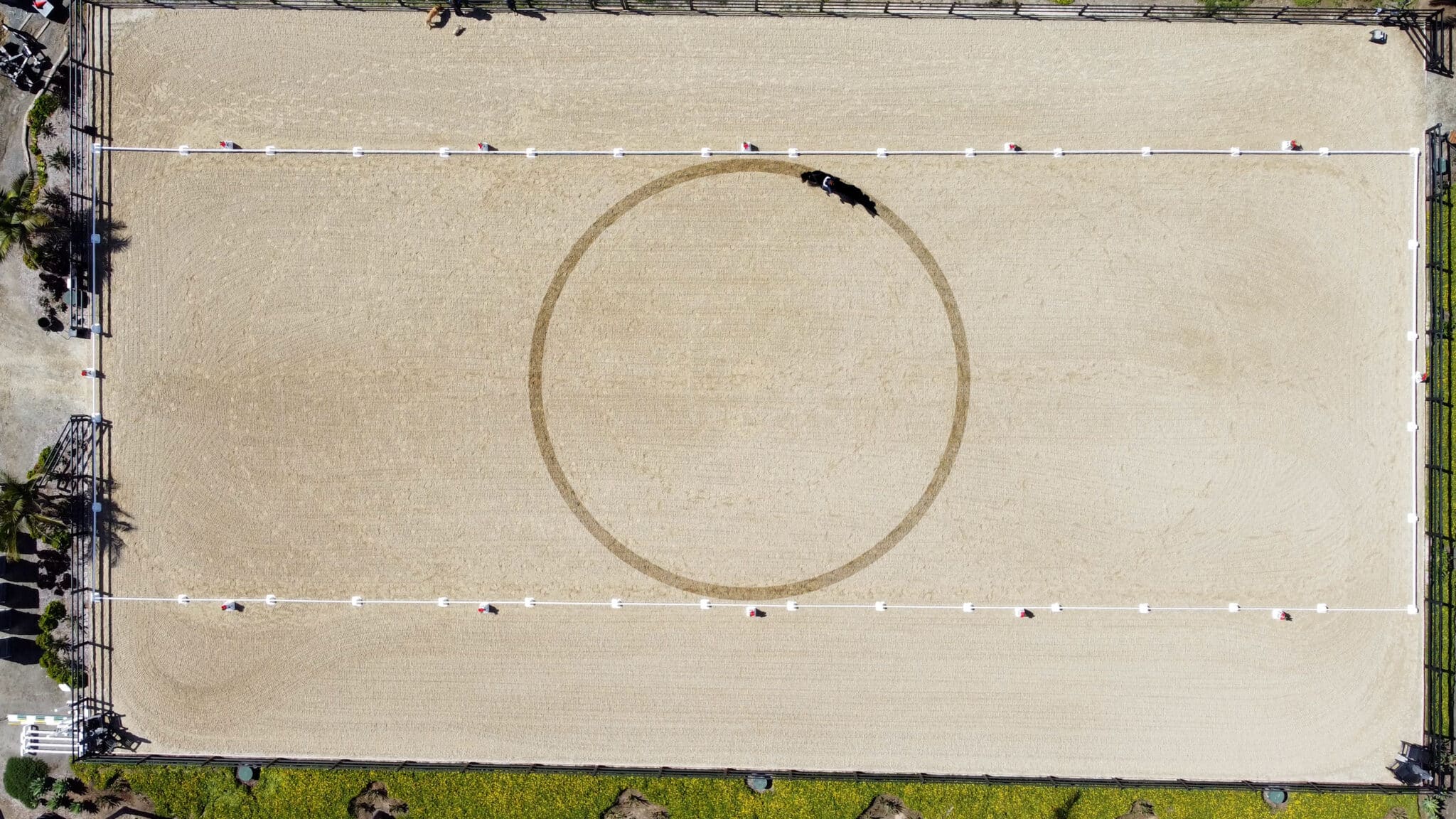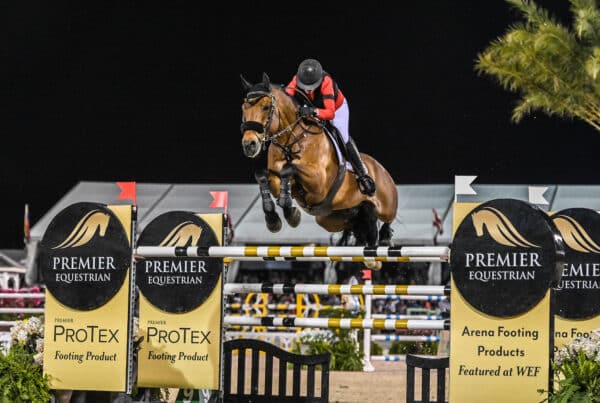In the world of dressage, a dedicated dressage arena is the stage for artistry in motion. Why is it so important to practice dressage in a dressage arena? The dressage arena acts as a training tool, enabling riders to develop their skills and master the intricate movements required in dressage.
Premier Equestrian recently sat down with Olympian Sabine Schut-Kery at The Palms Equestrian Center in San Marcos, California, to talk about the importance of training in a properly set-up dressage arena. Whether you’re a beginner rider or an experienced professional, the dressage arena offers the ultimate platform for growth and advancement. Ahead, we’re sharing six reasons why it’s important to regularly train in a dressage arena.

1. Refine Your Technique
“Dressage is all about achieving balance, suppleness, and obedience in the horse’s movements,” explains Schut-Kery. “The dressage arena provides a controlled environment that allows riders and trainers to focus on their communication, learn from their mistakes, and refine their techniques. The accuracy of the movement is what trains the horse. Riding the movement accurately will enable the horse to have the right bend and encourage hind–end engagement and balance in the horse. Allowing the exercise to aid in training, eliminates excessive pressure and helps to develop a harmonious cadence.”
The dressage arena fence will also prepare the horse for what they will experience at horse shows. This perimeter allows horses and riders to accurately gauge their movement for their test and help familiarize the horse with the dressage letters and flowers. Additionally, the dressage arena offers precise measurements and boundaries to allow riders to refine their movements with accuracy and symmetry. Letter placements identify the precise moment a movement or gait is to be changed. They help the rider to use the appropriate aids in a concise and timely manner.

2. Practice Your Corners
“For use of corner.” Sound familiar? If you’re competing in dressage, you’ve most likely heard this comment. Riding turns and corners is something everyone should practice. Corners and turns are used for rebalancing, setting up other movements, inside leg use, proper bend, among other things.
Training in any sized arena with 90˚ corners is a good start; you have something to work with! Access to a true 20×60 or 20×40 meter dressage arena allows you the time and space to practice getting that huge horse into that tiny corner. Get used to riding from a straight line into the corners, back to a straight line. Use the corners to set up lateral work, and rebalance your horse. Find out what’s difficult for your horse and work on that. It will improve your riding in more areas than just the corners.
“In my training, I like to use bigger lines without the dressage arena, but then it’s important for my training to ride through real corners—each corner is a quarter of a volte,” explains Schut-Kery. “There’s such a big difference riding through real corners, not getting to a show and then not being prepared, I often find horses hitting the rail with their hind legs. So, it really teaches you also to bend around the inner leg of the rider but also guard their hind legs and keep your horse straight, stepping through the longitudinal axis. And, to really get ready for a competition, the dressage arena teaches you to learn to ride with more precision from letter to letter. Through that work, when you ride with more precision from letter to letter, to get more suppleness in your horse, engagement, and collection. When we want to have days off from the dressage arena we take some of the rails out so we can use bigger lines outside of the arena.”

3. Learn Your Dressage Letters
Who chose these letters and why? Read more about the meaning behind dressage letters here. You just need to be familiar with what and where they are. Don’t forget about the center line letters and the quarter lines!
When you regularly ride in an arena with letters, their location becomes second nature. On show day, don’t rely on your reader if you choose to have one. Practice your test from memory to gain confidence in where you’re going so you can focus on the quality and accuracy of the movements; your reader becomes more of a reassurance if you suddenly go blank. Riding through a mistake and moving past it for the rest of the test is a skill in its own, so give yourself some real self-care and learn your test before hand.
“As a dressage judge, I cannot overstate the importance of training and practicing dressage tests in a properly set dressage arena with the correct measures,” says Cesar Torrente, FEI 4* Dressage Judge. “Dressage requires precision. All movements and transitions in dressage must be performed at certain letters, and you need them to practice and to perform accurately during your competition. Without a properly set up arena with the right measurements, it is difficult to practice accurately and to finally achieve exceptional results in the competitions.”

Knowing the letters can also be helpful during lessons, clinics, and riding in an arena away from home. Maybe the arena there doesn’t have all of the letters posted, maybe some are worn and faded, maybe your glasses broke before you got on and now you have to ride blind and orient yourself purely by the horizon line (I mean, unlikely but it is possible). If you’re told to do something at a letter, or a series of letters, it’s a nice feeling to know where their directing you to, instead of panicking and trying to figure out where you’re supposed to be.

4. Get Familiar with Dressage Arena Geometry & Lines
More comments everyone has seen on their score cards: “Circle too square,” or “Not straight.” Gauging straightness and size outside of an arena is like eating something savory when you have a cold. You can’t tell!
Practice straightness in an arena where you have straight sides to reference. Drag the arena and look at the hoof prints in relation to the rail. Use mirrors or ride toward someone down the centerline to know where your horse gets crooked. Ask a friend to film you so you can see what you can’t feel or aren’t aware of.
Practicing a 20 meter circle in a true 20 meter wide arena is harder than it sounds, but can tell you a lot about what’s going on with you and your horse. Making a round circle isn’t just about getting the line in the right place. Think about how your horse moves across the line. Maybe your horse braces, drifts out, or ignores an aid. Are you leaning, using too much of one leg, turning too early or late? The classic pyramid training scale is a great tool to simplify all of this. Read more about the geometry of the dressage ring.
As the tests get harder, the circles, turns, and lines get harder too. A 20 meter-wide arena makes 20 and 10 meter circles pretty straight forward. Now think about doing 15, 12, and 8 meter circles, loops, serpentines, leg yield from the quarter line, etc. Just as you need to practice straight lines with a reference, you need to have an accurately sized space to practice the size of your movements.

5. Do It For Your Horse
For those of us who have young, sensitive or spooky horses, giving them every opportunity to get comfortable in a new space is a must. When your horse isn’t worried about the arena or the flower boxes because he has seen them before, then you have all the more chance to ride a better test. Getting your horse used to riding close to the rail, and not having a meltdown if he does tap it with a hoof or kicks dirt up can be a huge advantage when you are juggling all the other complications riding a test can throw at you.
Teach your horse to respect the shorter rail. Goal: stay on the inside! We’ve all seen the videos of the horse jumping out of the arena. Training full-time in an enclosed arena can lead to problems when you suddenly don’t have that outside wall or fence. Walls and rails provide a nice boundary and can help us by acting as a crutch for the outside leg, help us control speed, or lessen distractions by creating a sort of bubble. However, riding in a 15” tall arena can when you and/or your horse aren’t used to it can feel very exposed.
The bottom line is that in order to find your peace within the white rectangle, you must actually ride in the white rectangle. So, get out there and ride some corners, trot some circles and leg yield to your heart’s desire.

6. Boost Confidence & Strength with Dressage Arena Footing
Another key element to boost confidence and strength in your dressage arena is having a stable, consistent riding surface. Dressage exercises such as lateral movements, changes of direction, and transitions require a consistent and even surface. A well-maintained dressage arena surface provides the necessary footing for such precision.
“It has been really wonderful to train on the consistent footing,” says Schut-Kery. “Good footing promotes confidence in the horse to learn new movements that require additional balance and the build-up of strength. Here at the Palms, we have been extremely happy with the ProTex Footing and the Arion Ebb & Flow system from Premier Equestrian.”
Bad footing can cause anxiety in horses. When the footing is deep, slippery, or very hard, horses worry about their balance and potentially falling or getting injured. Keep in mind a horse’s first instinct is not to fall down. Providing a dust-free, stable, and consistent surface will ensure the progression and training of a dressage horse through the levels. Whether it’s for competition, training, or simply the pursuit of harmony between horse and rider, the dressage arena plays a pivotal role in the art of dressage.





